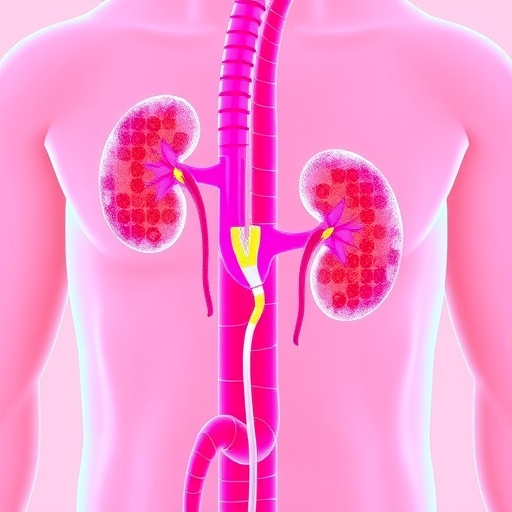
In recent years, the understanding of the intricate relationship between diabetes and renal function has continued to grow, unveiling a significant concern within the medical community: the links between elevated serum levels of certain biomarkers and the deterioration of kidney health in patients suffering from Type 2 Diabetes Mellitus (T2DM). One such biomarker, SERPINE2, is increasingly coming under scrutiny as researchers observe its potential implications in the realm of renal impairment associated with diabetes.
Diabetes remains a pervasive health challenge globally, affecting millions and leading to a range of complications, including cardiovascular disease, neuropathy, and notably, kidney disease. With the rising prevalence of Type 2 Diabetes, it is crucial for researchers to identify new biomarkers that can serve not only as indicators of disease progression but also as potential therapeutic targets. The work conducted by Cao, Tan, and Yang finds itself at the forefront of this research frontier as it comprehensively examines the role of SERPINE2 in the context of renal function.
The study explores a cohort of diabetic patients, delving into their serum levels of SERPINE2, which is a serine protease inhibitor that has been linked to various physiological processes, including inflammation and tissue repair. By examining the relationship between SERPINE2 levels and renal function parameters, the researchers seek to unveil the promising implications for early interventions in diabetic nephropathy. The significance of these findings may pave the way for developing new strategies in managing renal health among diabetic populations.
The research methodology employed by the team is rigorous, involving detailed serum sampling and advanced laboratory techniques to measure SERPINE2 concentrations. Investigators also performed comprehensive assessments of renal function through established parameters such as glomerular filtration rate (GFR) and serum creatinine levels. By correlating these metrics, they effectively demonstrated a clear association between elevated SERPINE2 levels and impaired renal function among study participants, heightening the urgency for further exploration of this biomarker.
What makes SERPINE2 particularly intriguing is its multifunctional role in various tissues, its involvement in fibrotic processes, and its potential implications in vascular health. Chronic hyperglycemia, a hallmark of diabetes, can induce significant alterations in the renal vasculature, leading to the development of nephropathy. Elevated SERPINE2 levels could serve as an indicator of underlying pathological changes occurring in the kidneys of diabetic patients, signaling not only a need for attention but also a potential pathway for therapeutic intervention.
Although the current research presents compelling evidence, it also opens the door for additional inquiries regarding the mechanisms that underlie the observed associations. Future work could delve deeper into how elevated SERPINE2 contributes to renal pathophysiology, particularly concerning inflammation and fibrosis. A clearer understanding of these mechanisms may lead to novel treatments aimed directly at modulating SERPINE2 activity, thereby safeguarding kidney health in those with diabetes.
Moreover, this study underscores the necessity for clinicians to closely monitor serum biomarkers like SERPINE2 as part of routine care for diabetic patients. Such monitoring could enhance patient management plans, guiding healthcare providers in making informed decisions about therapeutic interventions and lifestyle changes that contribute to renal health preservation. As more evidence emerges, it could become commonplace for SERPINE2 tests to be integrated into standard diabetes care protocols.
As the scientific community anticipates the publication of the complete findings from this study, there is a collective hope that these insights will contribute to better health outcomes for diabetic patients. It highlights the importance of interdisciplinary collaboration, merging insights from endocrinology, nephrology, and molecular biology to address one of the most pressing public health issues of our time — diabetes.
The ongoing exploration of SERPINE2 may also have implications beyond diabetes. Understanding its role in renal impairment could provide clues about broader biological processes that govern other age-related and chronic diseases. Researchers are urged to investigate SERPINE2 in various disease contexts, broadening the horizons of its potential impact on human health.
Meanwhile, patient education and lifestyle modification remain integral components of managing Type 2 Diabetes effectively. By raising awareness about the implications of serum biomarkers, healthcare professionals can empower patients with knowledge that promotes self-management of their conditions. Diet, exercise, and regular health check-ups should remain at the core of management strategies, even as the field advances with novel biomarkers and targeted therapies.
The increasing recognition of SERPINE2’s role serves as a reminder of the complexity of human biology and the interconnectivity of systems impacted by diabetes. As science continues to unveil the underlying dynamics at play, the hope remains that such advancements may lead to breakthroughs that fundamentally transform diabetic care, particularly in preserving renal function.
In conclusion, the exploration into the levels of serum SERPINE2 and their connection to renal function impairment in Type 2 diabetes patients offers a vital step towards improved patient outcomes. Continued research in this area is crucial as it promises to open new avenues for understanding and addressing the complications associated with diabetes, emphasizing the need for sustained engagement within the research community to unlock further advancements in diabetic care.
Subject of Research: The relationship between elevated serum SERPINE2 levels and impaired renal function in patients with Type 2 Diabetes Mellitus.
Article Title: Elevated Serum SERPINE2 Levels are Linked to Impaired Renal Function in Patients with Type 2 Diabetes Mellitus.
Article References:
Cao, S., Tan, Q. & Yang, L. Elevated Serum SERPINE2 Levels are Linked to Impaired Renal Function in Patients with Type 2 Diabetes Mellitus.
Diabetes Ther 16, 1313–1326 (2025). https://doi.org/10.1007/s13300-025-01742-7
Image Credits: AI Generated
DOI: https://doi.org/10.1007/s13300-025-01742-7
Keywords: SERPINE2, Type 2 Diabetes Mellitus, renal function, biomarkers, diabetic nephropathy, health outcomes, patient care.
Tags: biomarkers in diabetes managementchronic kidney disease and diabetesdiabetes and renal functiondiabetes biomarkers for disease progressiondiabetic nephropathy researchelevated serum levels in diabetesinflammation and kidney functionkidney disease risk factors in diabetes.renal impairment and diabetesSERPINE2 and kidney healththerapeutic targets in diabetesType 2 Diabetes Mellitus complications




